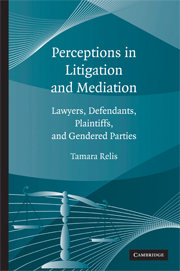Book contents
- Frontmatter
- Contents
- List of tables
- List of figures
- List of abbreviations
- Acknowledgments
- 1 Introduction
- 2 Great misconceptions or disparate perceptions of plaintiffs' litigation aims?
- 3 The voluntary versus mandatory mediation divide
- 4 Consequences of power: Legal actors versus disputants on defendants' attendance at mediation
- 5 Actors' mediation objectives: How lawyers versus parties plan to resolve their cases short of trial
- 6 Perceptions during mediations
- 7 Parallel views on mediators and styles
- 8 Conclusion: The parallel understandings and perceptions in case processing and mediation
- Bibliography
- Index
3 - The voluntary versus mandatory mediation divide
Published online by Cambridge University Press: 21 August 2009
- Frontmatter
- Contents
- List of tables
- List of figures
- List of abbreviations
- Acknowledgments
- 1 Introduction
- 2 Great misconceptions or disparate perceptions of plaintiffs' litigation aims?
- 3 The voluntary versus mandatory mediation divide
- 4 Consequences of power: Legal actors versus disputants on defendants' attendance at mediation
- 5 Actors' mediation objectives: How lawyers versus parties plan to resolve their cases short of trial
- 6 Perceptions during mediations
- 7 Parallel views on mediators and styles
- 8 Conclusion: The parallel understandings and perceptions in case processing and mediation
- Bibliography
- Index
Summary
“I guess the difference is in the culture or the mindset of the parties. I think in a perfect world we would have a voluntary system. But I don't think our society, our culture, is there yet where we can look at the benefits beyond a settlement outcome.”
Senior female – lawyer-mediator – in fortiesAs court-linked mandatory mediations (“MMP”) made up a material part of the dataset (twenty-three mediations), it was important to obtain a sense of actors' attitudes toward these mediations, as compared with voluntary mediations so as to more fully understand actors' mediation agendas and consequent experiences. By comparing lawyers', parties', and mediators' discourse in both mediation types, this chapter highlights the disparities in perception prevalent particularly within mandatory mediation case processing. Moreover, in offering frequently elusive data from litigants as compared with lawyers (Wissler 2002, p. 697), the findings expand on other studies that focus on evaluating particular mandatory programs or settlement rates (Macfarlane 1995; Metzloff et al. 1997, p. 115, n. 34).
Mandatory mediation is used in various jurisdictions for different case types due to low take-up rates of voluntary mediation, notwithstanding participant satisfaction (Pearson and Thoennes 1988, p. 448; Wissler 1997, pp. 565–66; Menkel-Meadow et al. 2006, p. 287). Critics of mandatory mediation have argued that it contradicts the consensual nature of mediation and mediation ideology that advocates disputants' self-determination. It has also been posited that without equal bargaining power, weaker parties are vulnerable to coercion to accept unfair agreements (Pearson and Thoennes 1988, pp. 431–32, 440; Thoennes et al. 1991, pp. 2–3;Wissler 1997, p. 565).
- Type
- Chapter
- Information
- Perceptions in Litigation and MediationLawyers, Defendants, Plaintiffs, and Gendered Parties, pp. 65 - 85Publisher: Cambridge University PressPrint publication year: 2009

